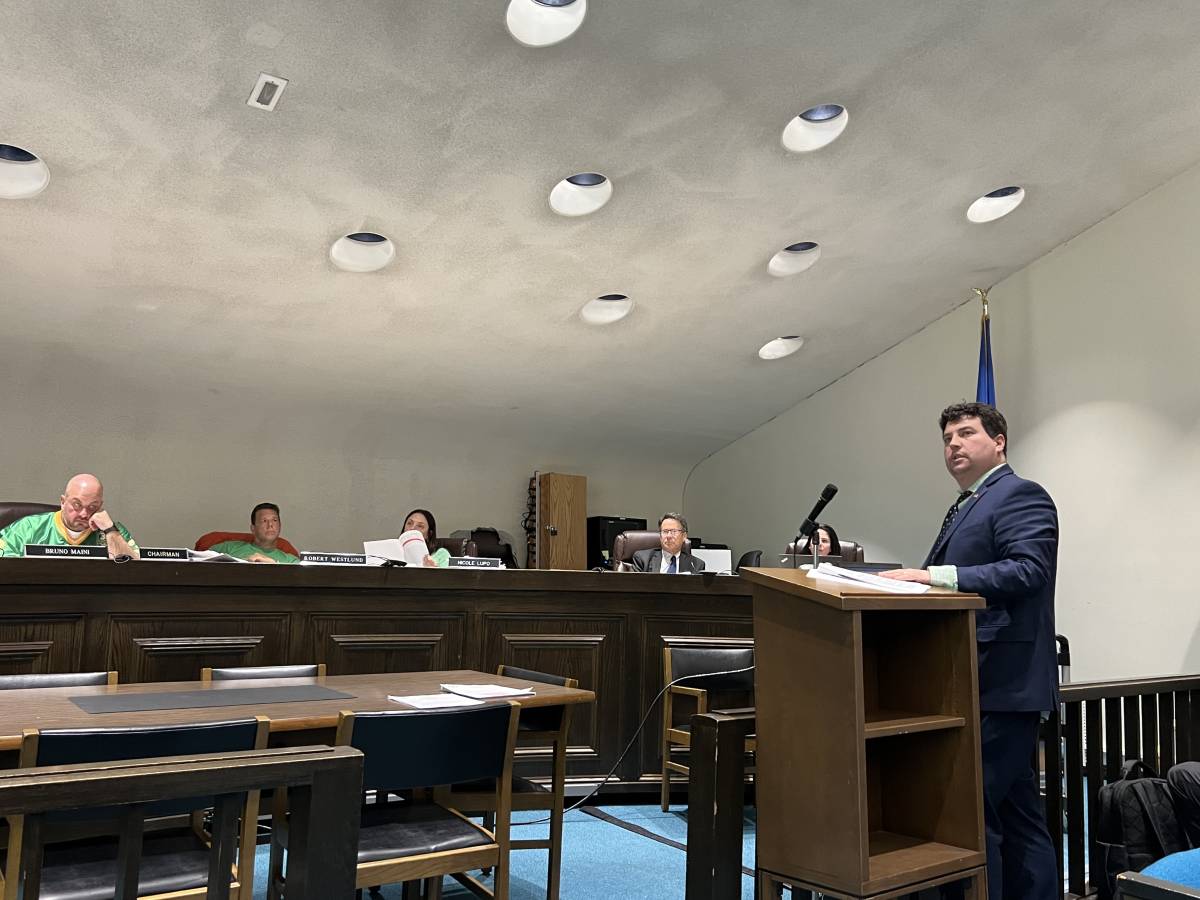MONROE, CT — A large tract of land on Turkey Roost Road and Cobblers Hill Court was the site of an illegal quarrying operation for decades, and neighbors have heard gunshots from hunters and the engines of ATVs from trespassers over the years.
The current owner, Dave Bienashski, has restored the damaged 150 acre plus property at 139, 141, and 201 Turkey Roost Road and 30 Cobblers Hill Court, and plans to build 99 four-bedroom homes in a community with a clubhouse, while preserving over 85 acres of open space.
But Planning and Zoning Commissioners and neighboring residents are expressing concerns over how many school-age children the development would bring, as well as the impact of heavier traffic on surrounding roadways.
“My client took over a property that was a moonscape with an illegal quarry and he remediated it,” Christopher Russo, the attorney for the applicant, told the commission at a hearing Tuesday night, “so I think this developer has done right by this property, which has been a significant headache for this town.”
Throughout the hearing, representatives of the applicant, reminded commissioners the site previously received an approval for a 90-unit age 55-and-older community that was never built, so the density had been allowed before.
Several commissioners took offense to this, because they said the 99 homes represent a new application that should be reviewed on its own merit, and some felt like they were being criticized for asking questions while doing their due diligence for the town and its residents.
Russo told commissioners they did not mean to give the impression they were discouraging them from asking questions.
“We will stay here until 3 a.m. We will answer questions,” he said. “This site was zoned for Multi-Family Residential and the regulations allow this level of development. That is already in place.”
Commissioners declined the offer of staying until 3 a.m., but the hearing still lasted over four hours before being continued to April 9.
Residents who spoke on Tuesday expressed concerns over traffic safety and doubt over numbers in the applicant’s reports, from the number of school age children and how much homes would sell for, to the projected tax revenue for the town.
They contend it would bring more than 70 students and that the development would be a net loss for the town. Concerns were also expressed over runoff, wells and potential damage from blasting.
Shells found
The proposal being brought by Quarry Ridge Associates LLC is for property in a split zone, Multifamily Residential (MFR) and Residential Farming 2 (RF-2). The housing units would be built in the MFR and the leeching fields for the septic would be in the RF-2.
Commissioner Leon Ambrosey contended each portion of a split lot must follow its zone and noted the applicant’s plan shows leeching fields in the RF-2. Russo said the MFR and the RF-2 are all residential.
Dominic Smeraglino, an alternate who was a seated commission member Tuesday, said he did a recent site visit and found 20 shells during his walk. “Usually hunters don’t pump off 20 rounds,” he said, “so I wonder if this was an outdoor shooting range at one time.”
Russo said it was not.
Bienashski, who acquired the property in 2003, said he never allowed hunting, but he’s not there all the time and people trespass to hunt.
Smeraglino asked if there was any testing for lead contamination and was told there was not. Because of about 50 years of hunting there, Smeraglino said, “I suggest extensive lead testing on this property.”
“We’re doing groundwater testing,” Russo said. “We’re bringing clean water onto the property,” he added of the public water the housing would use.
Smeraglino asked if there were underground fuel tanks for the large trucks when the property was used as a quarry. Bienashski said there were above ground tanks that were removed when he bought the property.
Bienashski said a Phase 1 remediation was done and no spills were reported or detected.
Smeraglino asked if there was soil testing and Bienashski said a Phase 1 does not include soil testing. Smeraglino and Nicole Lupo, a commission alternate both asked if soil testing can be done for the safety of residents in the area.
The site would be served by public water and an onsite sewage treatment plant. Russo said there is a gas line that his client wants to move closer to the development but, if that is too costly, homes could be heated by propane or electricity.
He said a licensed treatment plant operator must be hired by the homeowners association and be on call 24/7. In the event of a power outage, Russo said a generator could keep the plant running for up to 10 days.
Commissioner Robert Westlund said he is concerned that a spill from a septic system failure could end up in Smith Pond, raising bacteria levels.
Ambrosey said he wants to know the maximum amount of sewage the system can hold in the event of a failure, before it spills out.
Traffic issues
Russo said he initially believed a school bus could not enter a private property, but later learned that buses currently enter Great Oak Farms to pickup and drop off children, so his client is proposing a bus stop along Quarry Ridge’s driveway as a safer alternative to one on Turkey Roost Road.
Lupo said she wants a sidewalk in case the Board of Education does not allow a bus to enter the site, so kids are not standing on the edge of Turkey Roost Road while waiting for their bus.
Nick Havan, the principal transportation engineer of SLR, presented the traffic study. He said there have been 17 motor vehicle crashes on the road in the past five years — all single-car accidents with the exception of one sideswiping incident.
Ambrosey said he had asked for a traffic audit. And Russo said the accidents on Turkey Roost do not rise to the level for an audit to be done.
Instead, the town’s own expert did a peer review of Havan’s study.
The fact that most crashes involved cars hitting trees and utility poles shows how narrow Turkey Roost Road is, according to Ambrosey, who also said there are sightline problems where Turkey Roost, Fan Hill Road and Elm Street meet.
Though Havan’s accident data came from he Monroe Police Department, some commissioners doubted the number of crashes, instead contending it is higher.
Lupo said she witnessed at least two accidents on Turkey Roost Road, in which someone was T-boned pulling out, and Westlund said he has a friend who lives on the street who told him it was routine for drivers to lose control of their vehicles and end up in his front yard.
Westlund said those accidents are often not reported.
Domenic Paniccia, a commission alternate, asked how many more cars would be added during peak hours. Havan said 74 more cars in the morning and 98 in the afternoon.
“Our analysis shows this will not impact on traffic,” Havan said.
No affordable units
The developer estimates the units will be sold for around $800,000 each. The plan does not include units that would meet the state’s definition of affordable housing.
The state of Connecticut requires all municipalities to have a goal of at least 10 percent of its housing stock being affordable. Monroe is well below that and the state requires towns that do not meet the standard to show steady improvement.
“In Monroe we badly need affordable housing,” Paniccia said. “This development does not address this at all.”
“Your regulations don’t either,” Russo said. “The MFR does not require affordable housing. This type of development does not cater to affordable housing.”
“It actually hurts our requirements for affordable housing,” said Vice Chairman Bruno Maini, who served as acting chairman Tuesday.
Planning and Zoning Administrator Kathleen Gallagher confirmed that the MFR does not require affordable units.
“I understand it’s not a requirement, but it doesn’t help the town to reach its goal,” Maini said, adding other developers have worked with the town before.
Russo said affordable housing works better for rental units than in a community where residents own their home and utilities are not included and homeowners association fees can increase over time — making the cost of living higher than 30 percent of the resident’s household income.
He said a homeowners association could also require a special assessment for community amenities like a pickleball court or a dog park that would provide a challenge for someone selling an affordable unit.
“Say there is a $5,000 or $10,000 assessment everyone has to pay for a pool,” Russo said. “All the market value owners can bump up the sale price of their homes, because you have a swimming pool. Not the affordable unit owner, because their resale price is controlled. No matter how much money they put into it, they cannot recoup it on resale.”
“They’re in a trap essentially,” he said. “It almost disincentivizes you to invest in a unit. I understand this commission obviously tried to assess affordable housing, but in this development, it can really create difficulty for a unit owner. It is challenging.”
On another topic, Paniccia wanted assurance that the architecture would not result in “row houses” where all homes are the same exact design.
Bienashski said they will make sure that does not happen, especially when selling the homes for around $800,000 each.
Impact on public schools
Stanley Gniazdowski, president of Realty Concepts Incorporated, who performed an economic impact study, projects that 70 school age children would live in the 99 four bedroom single-family units.
Gniazdowski said Monroe’s population is dropping and trends based on lifestyles show women are having children at a later age and fewer children are being born.
Monroe averages 2.6 children per household, which is higher than many towns, according to Gniazdowski.
“I think it’s because people move here for the schools,” Commissioner Ryan Condon said. “I think the number of students will be higher.”
Gniazdowski said commissioners should also consider lifestyles. “I don’t think there will be a school age child in every unit,” he said.
Gniazdowski said a National Realtor Association report shows about 70 percent of homes have no children. But several commission members expressed doubt that only 30 percent of those interested in buying a four-bedroom home would have or plan to have children.
Lupo said she lives on a street with 10 houses and 16 school age kids.
“My report shows the average for Monroe. There are outliers,” Gniazdowski said.
He said studies find about eight percent of children go to private schools, adding that propensity is probably higher in Fairfield County. But in his study, Gniazdowski assumes all 70 children would attend Monroe public schools.
Gniazdowski said Police Chief Keith White told them the town would need to hire one more police officer to accommodate the development. Gniazdowski said this would benefit the entire town as well as the project.
He said the Monroe Volunteer Emergency Medical Service estimates there would be 45 more calls per year from the new housing. Gniazdowski estimates that would be at a cost of around $23,000.
Based on his revised projections, Gniazdowski estimates that Monroe would see $671,178 in positive tax revenue with the worst case scenario being $115,728.
He said the town would also receive significant revenue from one time fees not included in his study, such as conveyance taxes and permit fees. The spending power of Quarry Ridge residents would also help Monroe’s businesses, according to Gniazdowski.
Completion by 2030
The MFR requires at least half of a property to be preserved as open space. Quarry Ridge is proposing to preserve the 49.5 acres that are required, as well as an additional 35.7 acres. Russo said it would be used for passive recreation.
An exhibit was provided to show a fire truck can maneuver around the site and a letter from the fire marshal showed no concerns over the movement of trucks on the property, according to Russo.
The site would have an emergency access road as well as a main driveway. Town Engineer James DiMeo wanted some kind of a gate for the emergency access road, but Russo said the fire and police chiefs do not want something that would slow emergency responders down.
He said his client is considering something like a plastic break-away chain.
Russo said the roads and driveways within the complex would be paved and plowed by the homeowners association, not the town.
Russo said blasting would only needed in a few places for the site work, before construction begins. The project would be built in four phases with 2030 as the target date for completion.
All respectful comments with the commenter’s first and last name are welcome.







There is a hugh difference between over 55 plus housing that usually has a small number or no public school age childern and regular 3 to 4 bedroom homes where the presumption is for people to have 2 or more childern. To think that it is not going to be a ongoing burden for the town is absurd.